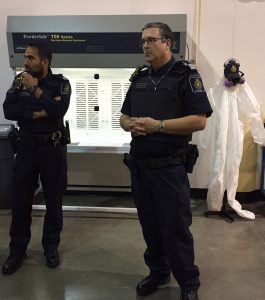Canada Border Tour – Day 3
Transport Canada
First on the agenda for our final day was a presentation at the Sutton Place Hotel by Transport Canada. We learned about the government agency’s role in developing regulations, policies, and services relating to transportation in Canada. The department has authority over the country’s road, rail, marine, and aviation, involving 50 acts, i.e. the Marine Act, Railway Safety Act. The 2030 Transport Canada Vision involves goals and investment in the areas related to the traveler, safe transportation, green and innovative transportation, waterways, and trade corridors.
We learned of Transport Canada’s Pacific Gateway and Corridor Initiative. The initiative is predicated on the notion that new opportunities are becoming available through the international movement of goods. This has presented Canada a unique opportunity to develop its international gateways based on the new intercontinental movements and by renewing policies, technologies, and infrastructure to improve access to the gateway corridors.
We also learned about Canada’s Ocean Protection Plan which was launched by Prime Minister Trudeau in November 2016. Canada has the world’s longest coastline and many people rely on the country’s waters in their daily life. The new plan set aside CAD$1.5 billion to improve marine safety and responsible shipping, protect Canada’s marine environment, and offer new possibilities for indigenous and coastal communities. The plan involves five departments, and includes a large oil tanker moratorium on the British Columbia North Coast.
Port of Vancouver
Next stop of the day was the Port of Vancouver.

The Port of Vancouver is Canada’s largest port and supports trade with more than 170 economies around the world. The port has the most diversified range of cargo of any port in North America; operating across five business sectors: automobiles, breakbulk, bulk, container, and cruise. In 2016, 136 million tons of cargo moved through the port, with a value of $200 billion.
The Port is concerned with trade issues, operations, environmental programs, and working with local communities.
On the environmental side, the cruise ships often turn off their diesel engines while docked and literally plug into Vancouver’s clean energy grid. Further, the Port has a pilot project of slowing the ships sailing in the lanes near the Port as they may impact the whales swimming in the same lanes.
The Port of Vancouver is home to 27 major marine cargo terminals and 3 class one railroads. Of these 3, we received a presentation from the transcontinental Canadian National Railway (CN Rail) and Canada Pacific Railway (CP Rail).
CN Rail and CP Rail both service the on-dock rail facilities at the Port’s container and cargo terminals. Being able to load and unload on the dock saves times and reduces potential damage of the products. Both railways offer services across Canada, as well as direct service to Chicago and other North American markets.
The CN Rail is the largest railroad in Canada with a diversified portfolio moving all kinds of goods. They service 12 ports in 10 cities in North America, and own seven private border crossings that are staffed by government officials. In addition, CN Rail has its own police operations in both the U.S. and Canada. CN was originally a Crown Corporation-government owned, but there was an IPO in 1995. Since then, CN has become more efficient, with greater customer satisfaction, and is operating as both a transportation and logistics company.
Rail Presentation (6M PDF)
CN Rail moves 5 million carloads over 22,000 miles with 25,000 employees. It is the only railroad with a three coast/border footprint — Canada’s east coast, Canada’s west coast, and the U.S. border. CN also has a private beltway around Chicago, avoiding congestion. Each CN rail car crossing the border goes through the VACIS machine — a huge X-ray machine — at the speed of 7 miles per hour. CN is a competitor to CP, however, they work closely with the other company, which goes only as Far East as Montreal.
CP Railway was established in 1881 and is closely tied to Canada’s history. They were the original innovators of intermodal and have now designed a 60-foot-long container. CP operates in 12 provinces and six states. The company has a balanced mix with 1/3 bulk, 1/3 merchandise, and 1/3 intermodal. CP has four private border crossings and is an industry leader in safety in North America. CP is currently looking at newly designed tanker cars DOT/TC117, which are provided by third parties and are expected to be much safer.
Our speaker also mentioned the Security and Emergency Response Training Center (SERTC) Program available to North American first responders for training in emergencies. Established in Pueblo, Colorado in 1985, the Security and Emergency Response Training Center (SERTC) is operated by the Transportation Technology Center, Inc. (TTCI), a subsidiary of the Association of American Railroads, in cooperation with the seven major railroads — BNSF, CN, CP, CSX, KCS, NS, and UP.
The original mission was to train railroad officials to safely handle accidents involving tank cars carrying hazardous materials. The training proved to be so successful that attendance was opened up to other emergency responders. They now serve not only the transportation service industry, but also the public sector emergency response community, the chemical industry, government agencies, and emergency response contractors from all over the world. Since inception, SERTC has trained more than 20,000 students worldwide
In addition, there is a new app, AskRail, whereby first responders can obtain information about the content of trains passing through their jurisdiction.
Pacific Central Rail Station
We also had the opportunity to visit the Pacific Central Rail Station. The magnificent building was completed in 1919 in the neoclassical revival style. In 1993, the station was converted into a multi-modal transportation facility with a bus concourse being added.
The station is home to the Northwest’s end of the Amtrak line. The Amtrak line, which provides daily trips from Vancouver to Seattle and Portland, has a unique immigration inspection set-up, called preclearance. The Amtrak passengers go through customs upon their arrival to the station, instead of stopping at the border for customs as some of the other trains do. We had the opportunity to see a presentation from the CBSA and the CBP to see how border security works at the station.
Vancouver International Airport
After the tour of the Pacific Central Rail Station, we headed to the Vancouver International Airport (YVR). Although we already had been here the previous day, we saw the airport from a different perspective this time. We watched presentations from the airport staff, CBSA, and CBP that showed us how the airport works to ensure security.
YVR, with one large passenger terminal, services 24 million passengers per year and is growing by 1 million annually. The airport is 20 minutes from downtown and has over 120 destinations worldwide via 56 airlines. The Vancouver Port Authority is set up by the federal government, but is a nonprofit organization with 500 employees. There is an innovation team designated to assist with issues. The BorderXpress and CheckitXpress processes and accompanying kiosks were from this group to assist with the long lines at the airport. These concepts have now been commercialized and are sold worldwide.
CBSA took our group on a walking tour around the airport, where we saw these security procedures happening first-hand for commercial and passenger flights out of the airport.
In the cargo section, new procedures have been established to deal with the increasing fentanyl shipments from Asia. We also saw a canine in action, Max who identified drugs which had been hidden as a part of the demonstration.


Conclusion
After learning about Canadian transportation and border security for the past few days, our trip had come to an end. Our bus crossed the border and was X-rayed with our delegation and luggage inside. We also left the bus, and had our luggage scanned again. This time crossing through CBP, we had a fresh understanding of everything that goes into the process.
Thanks
My appreciation to the Consulate General of Canada in San Francisco for extending an invitation to me. Our hosts in British Columbia were most informative and gracious. Our most congenial group experienced the efficiency of the Canadians, who are interested in security and border protection, but always with the concern for swift movement of goods and people — both so important to the Canadian and the U.S. economies.
A special thanks to my assistant, Nikki Ellis, who provided the research for the blog, and our Communications Department at the California Chamber of Commerce who always are willing to assist in promoting international trade and investment.
Related Articles
Prince Rupert and Vancouver Confront Growth Challenges
AJoT, April 23, 2018
Canadian Ports Maintain Growth Amidst Challenging Trends
AJoT, September 11, 2017
Grain and Iron Ore Exports Drive Seaway Cargo Surge
AJoT, September 11, 2017
Smaller Railroads Playing Bigger Role in Intermodal
AJoT, September 11, 2017
- Home
- Day 1:Tuesday, September 19, 2017
- Day 2:Wednesday, September 20, 2017
- Day 3:Thursday, September 21, 2017
 Blog By
Blog By
(Mrs.) Susanne Stirling
Vice President, International Affairs
susanne.stirling@calchamber.com
